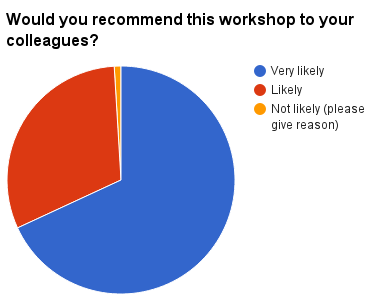 This is the first of our monthly posts introducing a member of the Ensembl team, and what they do in Ensembl. We’ll start with Emily Perry, who runs our Outreach team.
This is the first of our monthly posts introducing a member of the Ensembl team, and what they do in Ensembl. We’ll start with Emily Perry, who runs our Outreach team.
What is your job in Ensembl?
I’m in charge of the Outreach team. There are four of us, including me, and we’re essentially the contact point between all the scientists who use Ensembl and the developers who produce it. We work on things like online help and documentation, delivering training courses, social media, user-testing our new tools and displays, and answering questions via our email helpdesk. We’re always busy, and often have a half-empty office as someone is off delivering a training course somewhere around the world.
What do you enjoy about your job?
I’m one of those strange people who thrive when they have an audience, so I really love the teaching and presenting side of what I do. I’m also fascinated by the data that we have and love learning more about it and what people are using it for. I’m a biologist by trade, not a bioinformatician, but I’ve picked up a bit of coding as part of this job and one of the things I find most satisfying is fixing bugs in people’s code for them, without asking for help from our developers. I’ve also travelled to some amazing places to deliver workshops that I would never otherwise have gone to, such as Malawi, Colombia and South Korea, where I can really feel that I’m benefitting scientific progress.
What are you currently working on?
In Outreach we’re always dipping out of lots of projects, as well as all the reactive jobs we need to do like answering help emails or social media. A few of the things I have ongoing at the moment are looking into the documentation on the site, running a seven-week webinar course and preparing a conceptual course on genetic variation for the EBI’s Train Online platform.
What is your typical day?
Ha, there isn’t one. That’s one of the things I love about this job.
How did you end up here?
As I said, I’m a biologist. I studied genetics at undergrad, then went on to do a PhD in molecular biology. I knew about halfway through that I wanted out of the lab, so pursued a lot of science communication opportunities, both in person and written, as I went on, which led me to working for a year delivering science roadshows in secondary schools. This combination of communication skills and scientific expertise qualified me to start working as an Outreach Officer in Ensembl in 2012, then in 2015 I was promoted to lead the team.
What surprised you most about Ensembl when you started working here?
I had used Ensembl during my PhD, and I remember thinking that I knew what it was all about. Within a few days I was overwhelmed with just how much data and how many different types of data are in Ensembl. Turns out that my PhD work had barely scratched the surface of what was there. I hear the same thing all the time when I teach workshops: people who think they know all Ensembl has to offer (often the host of the course who was planning to just hide at the back and do other work during the course) tell me how surprised they are at all the useful things that are available.
What is the coolest tool or data type in Ensembl that you think everybody should know about?
I worked on chromatin for my PhD so my favourite data type is the regulatory build. I would have killed for those data back when I was a researcher. It’s just so useful having all the promoters, enhancers, CTCF binding sites (I love a bit of CTCF) and everything mapped onto the genome with its activity in different cell types. And I find the way that they just trained a computer to recognise patterns and assign functions from ChIP-seq data just amazing.




 The alignments and annotations generated from the data are viewable in the Ensembl browser, and the individual tracks can be configured using the RNA-seq tissue matrix. The initial introduction of this matrix was covered in a previous
The alignments and annotations generated from the data are viewable in the Ensembl browser, and the individual tracks can be configured using the RNA-seq tissue matrix. The initial introduction of this matrix was covered in a previous